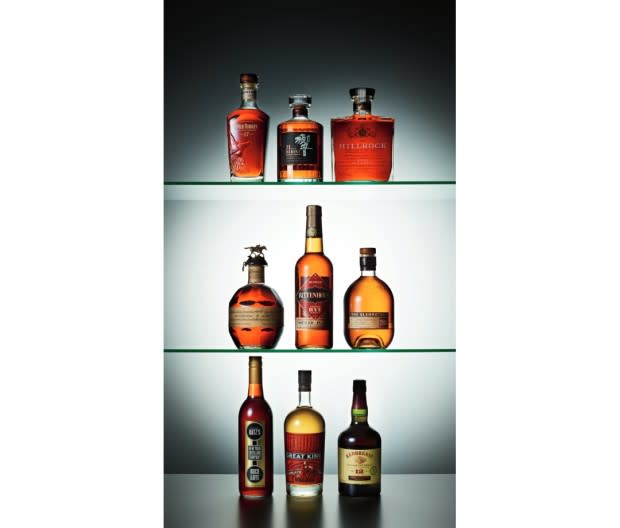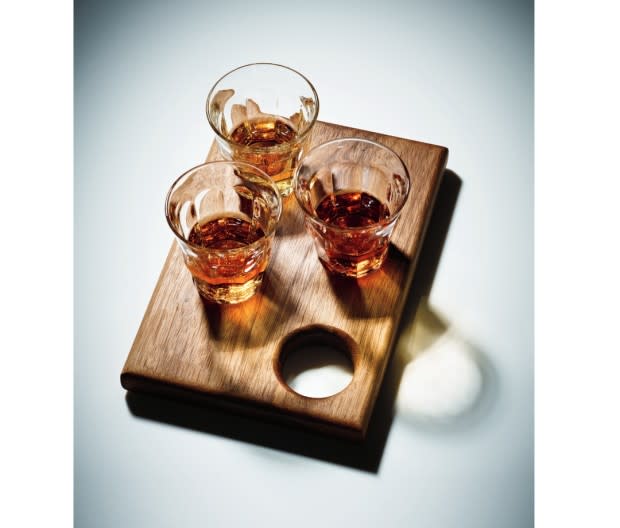Whiskey 101: A Complete Beginners Guide to Whiskeys
Beyond the fact that whiskey is golden brown and burns when you drink it, how much do you actually know about this spirit? Can you tell the difference between Scotch whisky and the American stuff? Or between bourbon and rye? What about a neat pour—what exactly does that mean?
You've probably picked up bits and pieces of whiskey 101 knowledge from a crowded bar or two, but it's time to set the record straight. To find the purest knowledge, you need to connect with the best teacher. And we could think of no one better than former Johnnie Walker Master Blender Jim Beveridge, who retired in 2021 after 40 years at Diageo, 20 of which were spent as a master blender.
We sat down with Beveridge to pick his brain about one of the best spirits you can stock in your liquor cabinet, and combined it with some of our own personal knowledge to put together this whiskey 101. Consider this the blueprint of whiskey for beginners.
Where Does Whiskey Come From?
Your whiskey 101 needs to begin with the fundamentals. If we’re talking about locations or destinations, these days whiskey (spelled with the "e" in U.S. and Ireland) and whisky (spelled without the "e" in Scotland, Ireland, U.S., Japan, India, Mexico, etc.) is coming from all corners of the globe. And the list just keeps growing.
From a more technical point of view, whiskey comes from fermented grain mash and water. It’s then aged in barrels of various types, most often oak, where it matures for years or sometimes decades, picking up the flavors of the barrel(s) it matures in.
What Are the Different Types of Whiskey by Region?
American Whiskey
There are mainly three types of whiskey coming out of America:
Bourbon
Bourbon
Bourbon has a rather strict set of rules around it, but some may be different than what you’ve heard. First off, bourbon does not need to be made in Kentucky, but 95 percent of it is (just as an added piece of knowledge, no, Bourbon County is not a dry county).
Bourbon can actually be made anywhere in the U.S., but it must be made in America.
It has to be aged for at least two years in a new charred oak barrel.
The mash must be at least 51 percent corn.
The whiskey cannot enter the barrel at higher than 125 proof (62.5 percent ABV) and can’t enter the bottle at a proof less than 80 (40 percent ABV).
Nothing can be added but water and only to lessen the proof when necessary.
Scotch Whisky
Scotch whisky flavors have a lot to do with terroir. Islay expressions tend to be peaty or smoky (and make for great campfire whiskeys), while those from Speyside are full of fruit. If you break it down, however, there are essentially two types of whisky made in Scotland: Single malt and blended.
Single Malt: Single malt Scotch is made in Scotland and distilled at a single distillery using a pot still distillation process. It comprises a mash of malted barley.
Blended: A blended Scotch can be a mix of both malt whiskies and grain whiskies, sourced from several different distilleries. Brands like Johnnie Walker, Dewar’s, and Cutty Sark are known for this.
Rye
From a makeup point of view, rye and bourbon are pretty similar, except rye's mash must contain a minimum of 51 percent rye, hence the name, and the rules about aging are slightly different.
Besides the rules, what’s the difference between bourbon and rye when it comes to flavor?
Bourbon vs. Rye
Knowing the difference between bourbon and rye is whiskey 101.
“To me, the big difference is the kind of wood in which the whiskey is matured, because bourbon whiskey has to be matured in American oak casks,” says Beveridge. He adds these distinguishing factors to help you tell the difference:
Bourbon has a first impression of fruit, which comes from the whiskey being matured. Then there’s this very distinctive sweet woodiness.
Rye tends to be lighter, doesn’t necessarily need to be matured in new casks, and has less woodiness.
Scotch has flavors that tend to be quite pronounced. There’s less flavor coming from the wood compared with bourbon, for example. The flavor is coming from the cask.

Levi Brown
Japanese Whisky
Japanese whisky can trace its history back to 1870, but really originated in 1923 with Yamazaki. The most famous houses are Suntory and Nikka, both of which produce several brands and types of whisky.
Irish Whiskey
Until about 15 years ago, there were two major distilleries in Ireland, Irish Distillers (currently owned by Pernod Ricard) in the Republic of Ireland and Bushmills (currently owned by Proximo) in Northern Ireland. Irish Distillers is responsible for many of the more familiar names in Irish whiskey, including Jameson, Powers, Redbreast, and Midleton Very Rare. Bushmills, in Northern Ireland, meanwhile, pretty much just makes Bushmills (a great whiskey for beginners).
Thanks to a recent revival in Irish whiskey, new distilleries have popped up everywhere from Dublin to Dingle, including Teeling (another good whiskey for beginners). Often, Irish whiskey is smoother because it’s triple distilled, while Scotch and bourbon are both double distilled.
Canadian Whisky
Canadian whiskies tend to be blends made from a single grain, often corn and rye. The best known brand is Crown Royal. Similar to Scotch and Irish whiskey, Canadian whisky has to be aged a minimum of three years in Canada.
Australia, Taiwan, India, Mexico, France, England, etc.
Today, new whiskey distilleries are popping up across the globe. In particular, Australian and Taiwanese whisky have been winning awards in major spirits competitions.

Levi Brown
What Are the Main Types of Whiskey and Subcategories?
Single Malt
Single malt whiskey uses only one type of grain and comes from a single distillery.
Blended Malt
These whiskeys combine several single malt whiskeys made in separate distilleries.
Blended Whiskey
Basically anything goes in this category as pretty much any whiskeys can be mixed together to create a blended whiskey.
Cask Strength (aka Barrel Proof)
This is usually the high-ABV (or proof) whiskeys. These bottlings skip the dilution process, instead opting to bottle straight from the cask.
Single Cask
These whiskeys are about as specific as things can get since they're bottled from one specific cask, rather than a combination of different barrels.
How Do You Taste Whiskey?
Heed these tips to drink whiskey like a pro.
1. Pour Lightly. You want an ounce or two at most.
2. Swirl the Whiskey, Then Smell. Let the whiskey coat the glass, then bring your nose above the glass. You don't want to be an inch from the liquid when you inhale, because it can burn out your olfactory system. Open your mouth as you inhale to let the alcohol fumes escape so you can better discern other flavor notes.
3. Add a Splash of Water to Your Glass. Water can help open up notes and flavors in whiskey. Add a bit of water or add ice and let it melt. If you drink your whiskey neat, take a sip of water from a separate glass from time to time to help release the flavors of the whiskey.
4. “Chew” Your Drink. Roll the liquid around in your mouth, exposing it to your entire tongue so you can pick up each unique flavor.
5. Breathe Through Your Nose. After you swallow, inhale so the fumes rise up into your sinuses. This is the best way to appreciate the spirit’s finish.
Editor's note: To determine the flavors present in a whiskey, you can also drop a bit into your palms and rub them together until the liquid evaporates. The scents that are left behind will give you an idea of what ingredients were used in the whiskey's creation.
How Do You Know If a Whiskey Is Good?
“At the end of the day, you'll have to taste it in order to form your own opinion, but if you’re starting at the very beginning, it's all about having confidence in the people who make the whiskey,” says Beveridge. “For example, Johnnie Walker is a whisky business that’s almost 200 years old, and it has a huge heritage of understanding how to produce great whisky. All of that rationale is kind of built into the bottle before you even open it.”
